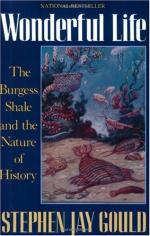
|
| Name: _________________________ | Period: ___________________ |
This test consists of 5 multiple choice questions, 5 short answer questions, and 10 short essay questions.
Multiple Choice Questions
1. What years did Whittington work on Naraoia and Aysheaia?
(a) 1980-1981.
(b) 1978-1979.
(c) 1977-1978.
(d) 1976-1977.
2. What kind of picture do scientists have of multi-cellular animal life because of the Burgess Shale?
(a) Distinct.
(b) General.
(c) None.
(d) Imagined.
3. What does Opabinia need?
(a) A new chordata.
(b) A new phylum.
(c) A new kingdom.
(d) A new species.
4. When did prokaryotic cells exist?
(a) At 3.7 billion years.
(b) At 3.5 million years.
(c) At 3.5 billion years.
(d) At 6.7 billion years.
5. What was once often a focus of the fauna?
(a) Amarella.
(b) Yohoia.
(c) Marella.
(d) Sidneyia.
Short Answer Questions
1. What did Bruton and Whittington do in 1983 in a monograph?
2. How was Whittington inclined to see Opabinia?
3. What did Whittington next begin work on?
4. Why is the Burgess Shale such an amazing find?
5. What did Whittington's revisions of the new paradigm become?
Short Essay Questions
1. What new view did Whittington hold after working on Naraoia?
2. What did Whittington originally think Naraoia was?
3. How did Naraoia contribute to the Burgess Drama?
4. How does the book describe Derek Briggs and Simon Conway Morris as students of Oxford?
5. How did Aysehaia contribute to the Burgess Drama?
6. What did Leanchoilica look like?
7. Why did classifying Naraoia pose a problem for Whittington?
8. Why did the Burgess Shale drama become a denouement by 1978?
9. What two major discoveries did Derek Briggs make?
10. What did Collins do when faced with the prevention of Des Collins excavation of Walcott's quarry?
|
This section contains 583 words (approx. 2 pages at 300 words per page) |

|




